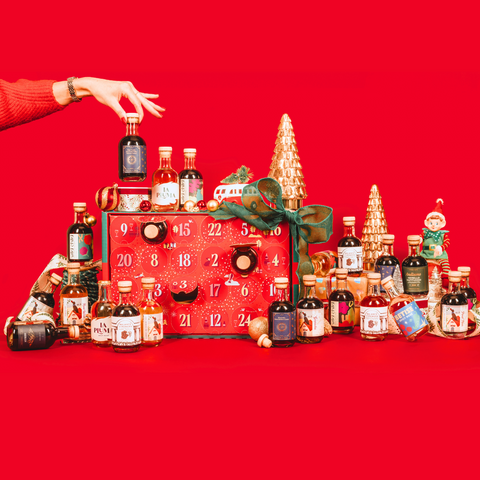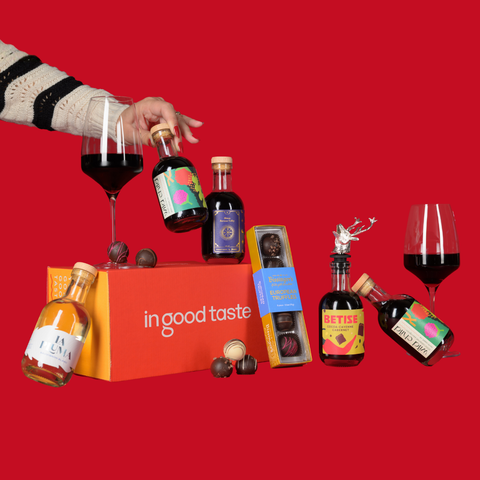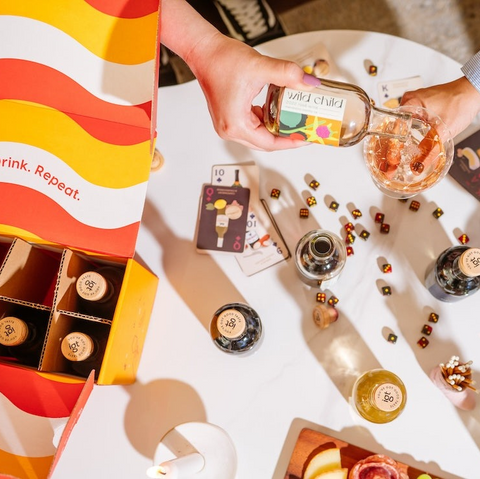A Summary of Italian Wine
Italy is simultaneously the most ancient wine-growing country and the forefront of modern wine techniques. Today, Italy produces the largest volume of wine in the world and every single one of its 20 regions has at least one vineyard. It has 590 native grape varieties and over 500 unique styles of wine.
The distinct boot-shaped country has a rich history in the wine world. Between the perfect wine-growing climate and the Italian preference for native varietals, Italy has a lot to offer the novice wine lover.
Short History of Italian Wine Beginnings
Natives of the Italian peninsula have been making wine for over 4000 years. Both the Etruscans and the Romans took great interest in producing wine and over the years Italian winemaking practices and traditions evolved and grew. When the Greeks arrived in the 8th century B.C., they named it “Oenotria” which means “the land of wine.”

The Romans believed that wine was a necessary part of democracy and worked to make wine available to all classes of people, from the peasants to the aristocrats. Many of the techniques used in modern Italy were formed during the time of the Romans. Wine rose even further when it became associated with the “blood of Christ” in the Catholic sacrament.
Like many European countries, Italy suffered from the phylloxera pest in the 1900s which forced winemakers to focus on quantity over quality to make up for their losses. The result is that in the 1900s Italy became known for cheap, delicious table wines. It wasn’t until the 1960s that the quality of Italian wine was vindicated with the introduction of the Denominazione d'Origine Protetta (DOP) or protected designation of origin.
Italian Wine Quality Control: IGT, DOC, DOCG
Today Italy is known for both the quality and quantity of its wines. Table wines, or vinos da tavola (VdT), are widely made and drunk across the country, but the real high-quality wines are found in the Denominazione d'Origine Protetta (DOP). This system was introduced in the 1960s and hugely influenced modern Italian winemaking.

DOC
Denominazione di Origine Controllata (DOC), or Denomination of Controlled Origin, was the first to be introduced. This title was only bestowed on wines that met certain criteria such as wine color, grape varieties, and alcohol levels. It also ensured that winemakers followed certain viticultural, vinification and maturation techniques.
Many modern Italian wines that bear the titles of Chianti, Brunello di Montalcino, vino nobile di Montepulciano, Barolo, and Barbaresco qualify as DOC wines. All in all, 334 wines fall under the title of DOC.
Super Tuscans
After the DOC was introduced, many winemakers rebelled against the restrictions which they thought would kill off innovation in Italian wine. As a result, the Super Tuscans were born and a new denominazione was created. Super Tuscans were among the first to include varietals from outside Italy, namely Cabernet Sauvignon.
IGT
If table wines make up a majority of Italian drinking wine, Indicazione Geografica Tipica (IGT) is the next level up. The IGT title has the fewest regulations and allows winemakers the freedom to experiment.
DOCG
The Denominazione di Origine Controllata e Garantita (DOCG), or Denomination of Controlled and Guaranteed Origin, came a bit later in 1980. This title was awarded to the highest quality wines in Italy. Once again Brunello di Montalcino and vino nobile di Montepulciano in Tuscany, and Barolo and Barbaresco in Piedmont made the cut. Only 74 DOCG’s exist in Italy today.
However, the DOCG isn’t as reliable as it sounds. Since the title applies to a region and not a specific wine, the quality of DOCG wines can vary based on the year, climate, and location where its made.
The truth is that you can find quality wines in Italy no matter what their qualifications. Table wines, IGT, DOC, and DOCG are only a guideline to the many levels of winemaking in Italy.
Reading a Wine Label: Other Italian Words to Know
Riserva: A wine aged for longer than usual. Rules vary depending on denominations.
Superiore: A high-quality designation added to a regional name (i.e., Chianti Superiore).
Azienda Agricola: A farm or estate that produces the grapes it uses in the production of its wines.
Annata or Vendemmia: A specific harvest or vintage.
Produttore: Producer
Tenuta: Estate
Vigneto: Vineyard
Italian Terroir
The terroir of Italy is extremely varied as the soil, climate, proximity to the ocean, and topography change depending on where you are in the country. If you look at a map of Italy’s regions, you will see that wine is grown across the continent in every climate and geographical region. A few of the major factors that affect terroir in Italy are the mountains (Alps and Apennines), lakes (Lake Garda, Lake Iseo), oceans and seas (Tyrrhennian, Adriatic, Ionian), soil type (glacial and volcanic), topography (hills, plains, mountains), and the climate.
Grapevines grow in almost every part of Italy. Many of the wines grown in Italy are table wines meant to be consumed shortly after fermentation. Italian red wine is also made to reflect the food of the region. In Italy, wine and food are inexorably tied. Full-bodied reds are especially popular since they stand up to the strong flavors of tomato sauces, plates of pasta, and cured meats.
Italy can be divided into three main regions: northern, central, and southern.

Northern Italy
Areas in Northern Italy - including Piedmont, Trentino Alto-Adige, Veneto, Lombardia, Valle d’Aosta, and Friuli - are influenced by its proximity to the Alps. A longer growing season is needed because of the continental climate, rain, and heavy fogs. Northern Italy is known for dry, tannic reds like Barbera, Nebbiolo, Amarone, and Dolcetto, and sweet or tart whites such as Moscato, Pinot Grigio, Valpolicella, and Chardonnay.
Central Italy
Regions in Central Italy, such as Tuscany, Umbria, and Abruzzi, are affected by the moderate, Mediterranean climate. Green, rolling hills and hot summers make for the perfect wine-growing conditions. Tuscany is known for its tannic red Sangiovese and the international varieties of Cabernet Sauvignon and Syrah which often get blended with native Italian varietals. For Italian white wine, central Italy is known for the citrus and mineral notes of its Trebbiano Toscano and Vernaccia wines.
Southern Italy
In Southern Italy, regions such as Campania, Calabria, and Sicily are primarily coast and prairie. The climate is dry and sunny and winemakers are producing full-bodied reds and whites. The primary red varietals include Nero d’Avola, Carignano, Aglianico, and Primitivo, while the Italian white wines are generally made with Grillo, Falanghina, and Vernaccia.
Top Italian Wine Regions
The top three Italian wine regions are Tuscany, Piedmont, and Veneto. Italy has 20 regions overall and 1,730,000 acres of vineyards. With over 2,000 grape varieties, Italy plays host to a great variety of wine and wine styles. The best-known grapes across the country are Sangiovese, Barbera, Nebbiolo, Montepulciano, and Pinot Grigio.
TUSCANY
Acreage of Vineyards: 157,000 acres
Popular Varietals:
- Sangiovese (⅔ of all grapes in Tuscany)
- Cabernet Sauvignon
- Merlot
- Trebbiano
- Malvasia
- Vermentino
- Vernaccia
Well-Known Styles:
- Super Tuscan
- Chianti
- Brunello di Montalcino
- Vino Nobile di Montepulciano
- Sassicaia
- Vin Santo
- Vernaccia di San Gimignano
The rolling hills of Tuscany are characterized by limestone, sandstone, and clay soils. Depending on if you are close to the coast in the west or mountains in the east, Tuscan wine flavor profiles can vary greatly.
Some of the best wine in the world comes from Tuscany. Tuscany is known for Chianti, Brunello di Montalcino,Vino Nobile di Montepulciano made with the Sangiovese grape. Super Tuscans which fall under the IGT system of classification are a newer blend out of Tuscany that incorporates international grapes like Cabernet Sauvignon alongside native varietals.
Although typically used for high-end red wines, Sangiovese also makes a delicious Italian rosato or rosé. rosés from Sangiovese grapes tend to have a balance of sweet, savory, and mineral flavors.
PIEDMONT
Acreage of Vineyards: 108,400 acres
Popular Varietals:
- Nebbiolo
- Barbera
- Moscato Bianco
Well-Known Styles:
- Barolo
- Barbaresco
- Barbera d'Asti
- Moscato d'Asti
Piedmont means “at the foot of the mountains” and that is where you will find this quality-driven wine region. Piedmont is better known for its red wines, but the popular white Moscato d’Asti has been growing in popularity. The vineyards at the foot of the Alps produce more DOCG wines than any other region in Italy.
Nebbiolo makes the full, tannic Barolo wine that Piedmont is known for which has a trademark “tar and rosés” bouquet. Both Barolo and Barbaresco are meant to be aged for at least a few years (strict DOC guidelines require Barbaresco to age at least two years before release, and Barolo for three). Barbera, a wine synonymous with Piedmont, produces a light red wine with few tannins. Producers in California have had some success with this quintessential Italian variety.
VENETO
Acreage of Vineyards: 220,000 acres
Popular Varietals:
- Corvina
- Corvinone
- Rondinella
- Glera
- Garganega
- Trebbiano
Well-Known Styles:
- Amarone di Valpolicella
- Soave
- Prosécco
- Pinot Grigio
Veneto is located in the middle of the northern Alpine regions and warmer, drier lands of the south. Unlike Tuscany and Piedmont, Veneto is well-known for both its reds and whites. The classic Amarone di Valpolicella is a rich, dry red that uses passito (dried) grapes to get a jammy, raisin-like flavor. Prosécco is grown in the northeast corner from the native glera grape and the dry Soave features the popular Garganega. Valpolicella is the only DOC to rival Tuscany’s Chianti in terms of production volume. Although only 25 percent of Veneto’s wines fall under DOC, you can find amazing value and quality from Veneto. A trick to finding great wines from Veneto? Look for the V’s- Verona, Vicenza, Valpolicella, Valpantena, Valdobbiadene, and Venezia.
New World winemakers in Washington and California have both taken inspiration from the wine growing regions of Italy with varying degrees of success. Washington state producers successfully incorporated Italian native Sangiovese into their vineyards to create dry, slightly sweet rosés that may one day compete with the traditional wines of Italy. The Sierra Foothills in California are the only place where you can find Sangiovese but Italy’s influence on California exists in the techniques and production of most modern California wines.
Tuscany, Piedmont, and Veneto account for less than a third of the total wine-growing acreage in Italy. Many of the lesser-known regions tend to have a specialty that makes them stand out from the crowd.
Emilia Romagna makes a delightful sparkling red Lambrusco while Lombardy is known for Italian sparkling wines. The Marche appellation specializes in Verdicchio dei Castelli di Jesi, a dry white wine, while Sicily’s Nerello Cappuccio draws on the deep volcanic flavors from the nearby Mt. Etna. Each of Italy’s 20 regions has some claim to fame and the only way to find your favorite is to try them all.
Production, Exports, Imports
Italy is the world’s largest producer of wine with an average annual production of 50 million hectoliters. A good portion of Italian wine never goes further than a few miles from where it was made. Each Italian consumes an average of 13.6 gallons of wine a year, with 20% of people consuming at least one alcoholic beverage per day.
The United States received most of Italy’s exports in 2020 (about 23.1%) followed by Germany (17.1%), and the UK (11.4%). Almost 60% of the total exports from Italy come from Veneto (542 million euros), Tuscany (246 million euros), and Piedmont (235 million euros). Popular exports include Chianti, Brunello di Montalcino, Valpolicella di Amarone, Prosécco, Soave, and Lambrusco.
Big Challenges the Wine Industry is Facing




Tourism
Italian wine tourism brings in over 3 million dollars of revenue each year. Wine tourism started with 25 wineries with private tours in 2002 but quickly expanded to over 21,000 vineyard tours modern day. About 4 to 6 million tourists flock to Italy each year to experience its unique wine culture first hand.
Sustainability Practices
In the past several years, Italy has made great strides toward improved sustainability in their winegrowing regions. Equalitas was launched in 2016 to unite the Italian wine business toward a shared vision of sustainability. The Unione Italiana Vini (UIV), the trade union for wine producers, and the Federdoc (handers of the DOC, DOCG, etc) work together to promote more sustainable practices in soil handling, biodiversity, manufacturing, communication, workers rights, and more.
Problems and Limitations
The very systems put in place to ensure the quality of Italian wine are one of their greatest limitations. If it weren’t for innovative winemakers willing to break outside of the box, Italy would quickly fall out of touch with trends and changing tides within the greater world of wine. Super Tuscans are a notable example of winemakers in Italy who are thinking past the DOC and DOCG designations to make wines with new grapes and techniques. Their increasing popularity shows how important innovation can be in the changing wine industry.
Italy has also been hit hard by the changes from climate change. Rising temperatures result in grapes with more sugar and less acidity. This means that wines are getting sweeter and boozier - both of which are not typical qualities of a fine wine.
Big Challenges the Wine Industry is Facing


Fun Facts
-
If you’ve ever bought a bottle of Chianti Classico, you may have noticed a rooster seal. This seal is a sign of authenticity and alludes to a legend related to the Chianti region. Legend says that a conflict over the borders of the Chianti region between Siena and Florence led to a horse race which would decide the territorial dispute. As soon as the rooster crowed, a rider from each location would set out across the land and wherever they met would mark the new border between the two counties. But Florence kept their rooster in a cage, hungry for days before the race which resulted in it crowing a few hours before dawn. Because the rider from Siena left hours later, the rider from Florence was able to ride much further, increasing the boundaries for Florence.
-
Appassimento is an interesting Italian winemaking technique that is used in the popular Amarone di Valpolicella. Appassimento is when the winemaker partially dries out the grapes which are then slowly pressed and fermented. The yeast on the grapes has longer to feed on the sugar of the grapes, raising the eventual alcohol content. Common tasting notes include raisins, cherry liquor, and black fig. Vin Santo is also made using the appassimento method. This late-harvest, dessert wine is produced in Tuscany and its name translates to Holy Wine.
-
After WWII, many Italian winemakers emigrated down under where they took advantage of the climate similar to that of the Mediterranean to create Australian wines with Italian techniques.








